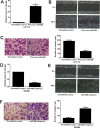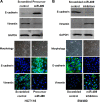LncRNA CHRF-induced miR-489 loss promotes metastasis of colorectal cancer via TWIST1/EMT signaling pathway
- PMID: 28430582
- PMCID: PMC5482664
- DOI: 10.18632/oncotarget.16850
LncRNA CHRF-induced miR-489 loss promotes metastasis of colorectal cancer via TWIST1/EMT signaling pathway
Abstract
microRNA-489 (miR-489) is a novel cancer-related miRNAs and functions as a tumor suppressor in human cancers. While, the clinical significance of miR-489 and its role in colorectal cancer (CRC) remain rarely known. Here, we found that the levels of miR-489 in CRC tissues were significantly lower than those in matched tumor-adjacent tissues. Furthermore, decreased levels of miR-489 also observed in CRC cell lines compared to HIEC cells. Clinicopathological analysis revealed that miR-489 underexpression was positively correlated with advanced pT stage, pN stage and AJCC stage. Moreover, miR-489 low expressing CRC patients showed a obvious shorter survival. Functionally, miR-489 restoration inhibited cell migration and invasion as well as epithelial-mesenchymal transition (EMT) in HCT116 cells, while miR-489 loss facilitated these cellular processes in SW480 cells. In vivo experiments revealed that miR-489 overexpression reduced the number of metastatic nodules in nude mice liver. Notably, TWIST1 was recognized as a direct downstream target of miR-489 in CRC cells. Interestingly, TWIST1 restoration abrogated the effects of miR-489 on CRC cells with enhanced cell migration, invasion and EMT process. Furthermore, overexpression of long noncoding RNA cardiac hypertrophy-related factor (lncRNA CHRF) was inversely correlated with miR-489 expression in CRC tissues. CHRF knockdown increased the expression of miR-489 and suppressed EMT events of HCT116 cells, while CHRF overexpression showed opposite effects on miR-489 expression and EMT in SW480 cells. Taken together, this work support the first evidence that lncRNA CHRF-induced miR-489 loss facilitates metastasis and EMT process of CRC cells probably via TWIST1/EMT signaling pathway.
Keywords: CRC; LncRNA CHRF; TWIST1/EMT; metastasis; miR-489.
Conflict of interest statement
All authors declare no conflicts of interest.
Figures









Similar articles
-
PDGF-D promotes cell growth, aggressiveness, angiogenesis and EMT transformation of colorectal cancer by activation of Notch1/Twist1 pathway.Oncotarget. 2017 Feb 7;8(6):9961-9973. doi: 10.18632/oncotarget.14283. Oncotarget. 2017. PMID: 28035069 Free PMC article.
-
The long noncoding RNA TUG1 is required for TGF-β/TWIST1/EMT-mediated metastasis in colorectal cancer cells.Cell Death Dis. 2020 Jan 27;11(1):65. doi: 10.1038/s41419-020-2254-1. Cell Death Dis. 2020. PMID: 31988275 Free PMC article.
-
LncRNA TUG1 promoted KIAA1199 expression via miR-600 to accelerate cell metastasis and epithelial-mesenchymal transition in colorectal cancer.J Exp Clin Cancer Res. 2018 May 18;37(1):106. doi: 10.1186/s13046-018-0771-x. J Exp Clin Cancer Res. 2018. Retraction in: J Exp Clin Cancer Res. 2021 Feb 04;40(1):55. doi: 10.1186/s13046-021-01855-4. PMID: 29776371 Free PMC article. Retracted.
-
The interplay between non-coding RNAs and Twist1 signaling contribute to human disorders.Biomed Pharmacother. 2021 Mar;135:111220. doi: 10.1016/j.biopha.2021.111220. Epub 2021 Feb 1. Biomed Pharmacother. 2021. PMID: 33433357 Review.
-
The role of the miR-200 family in epithelial-mesenchymal transition in colorectal cancer: a systematic review.Int J Cancer. 2018 Jun 15;142(12):2501-2511. doi: 10.1002/ijc.31282. Epub 2018 Feb 21. Int J Cancer. 2018. PMID: 29388209
Cited by
-
Molecular mechanisms of long noncoding RNAs-mediated cancer metastasis.Genes Chromosomes Cancer. 2019 Apr;58(4):200-207. doi: 10.1002/gcc.22691. Genes Chromosomes Cancer. 2019. PMID: 30350428 Free PMC article. Review.
-
The ceRNA network regulates epithelial-mesenchymal transition in colorectal cancer.Heliyon. 2023 Mar 1;9(3):e14143. doi: 10.1016/j.heliyon.2023.e14143. eCollection 2023 Mar. Heliyon. 2023. PMID: 36950593 Free PMC article. Review.
-
Novel role of lncRNA CHRF in cisplatin resistance of ovarian cancer is mediated by miR-10b induced EMT and STAT3 signaling.Sci Rep. 2020 Sep 8;10(1):14768. doi: 10.1038/s41598-020-71153-0. Sci Rep. 2020. PMID: 32901049 Free PMC article.
-
Long non-coding RNAs as the critical regulators of epithelial mesenchymal transition in colorectal tumor cells: an overview.Cancer Cell Int. 2022 Feb 10;22(1):71. doi: 10.1186/s12935-022-02501-5. Cancer Cell Int. 2022. PMID: 35144601 Free PMC article. Review.
-
Long non-coding RNA, CHRF, predicts poor prognosis of lung adenocarcinoma and promotes cell proliferation and migration.Oncol Lett. 2018 Nov;16(5):6245-6252. doi: 10.3892/ol.2018.9425. Epub 2018 Sep 7. Oncol Lett. 2018. PMID: 30333887 Free PMC article.
References
-
- Potter JD, Hunter D. In: Genetics of Colorectal Cancer. Springer; 2009. Colorectal cancer: epidemiology; pp. 5–25.
-
- Van Cutsem E, Nordlinger B, Cervantes A, Group EGW. Advanced colorectal cancer: ESMO Clinical Practice Guidelines for treatment. Annals of Oncology. 2010;21:v93–v97. - PubMed
-
- De Roock W, Piessevaux H, De Schutter J, Janssens M, De Hertogh G, Personeni N, Biesmans B, Van Laethem JL, Peeters M, Humblet Y. KRAS wild-type state predicts survival and is associated to early radiological response in metastatic colorectal cancer treated with cetuximab. Annals of Oncology. 2008;19:508–515. - PubMed
-
- Cao H, Xu E, Liu H, Wan L, Lai M. Epithelial-mesenchymal transition in colorectal cancer metastasis: A system review. Pathol Res Pract. 2015;211:557–569. - PubMed
MeSH terms
Substances
LinkOut - more resources
Full Text Sources
Other Literature Sources
Medical

